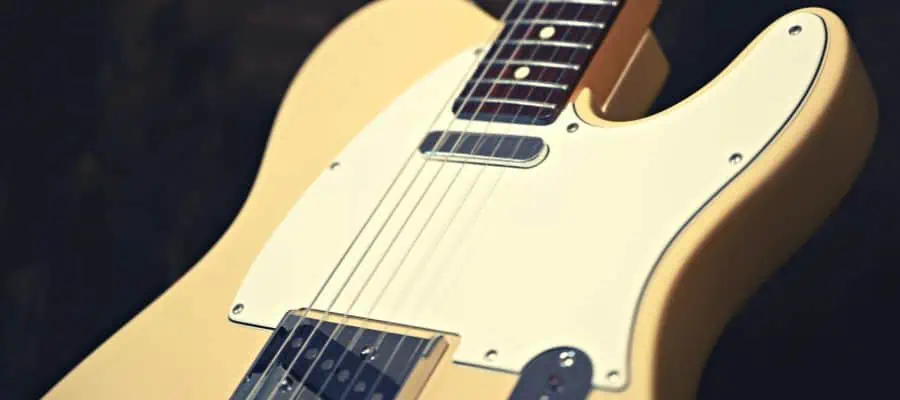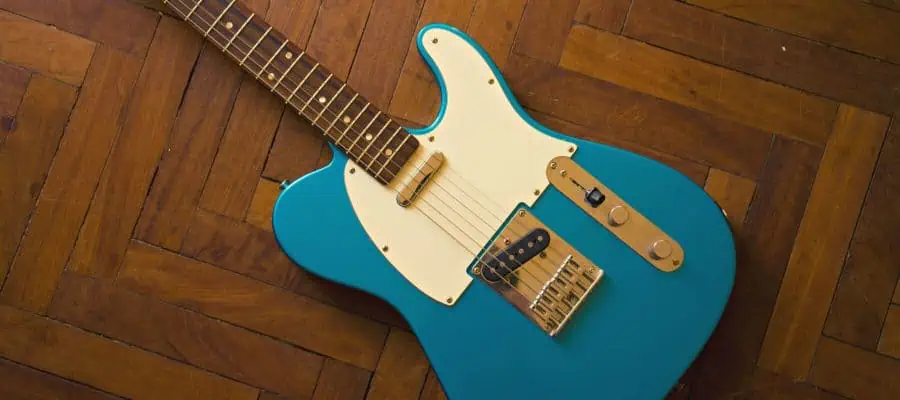Fender Telecaster is one of the legendary symbols of music history with its sleek design as well as unique twangy sound. Known for their bright and twangy sound, Telecasters are sonic chameleons that perform greatly in a wide variety of genres, from country to rock music. But have you ever wondered about the secret behind that unique tone?
The unique sound of Telecaster is created with a combination of factors such as the fixed brass bridge, single-coil pickups with distinctive designs like the metal-covered neck pickup and angled bridge pickup with the bottom plate, and body design with slightly more wood than other guitars. With all these features together, Telecasters produce that legendary twangy sound that etched its mark in music history.
So, in this article, I will explain in detail how these factors affect the tone of Telecasters to figure out the secret recipe behind the iconic Tele sound.
The Bridge

One of the main factors of the twangy Tele sound is the fixed bridge, which is directly connected to the body. The bridge has the body stringing, meaning that the string vibrations are directly transported into the body through the brass saddles. The brass bridge and the body stringing are crucial to the twang of a Tele.
For instance, Stratocasters have a floating bridge in which the string vibrations go through a sustain block before getting dampened by the springs of the tremolo bridge.
Telecasters traditionally feature a 3-saddle brass bridge. The brass leads to a brighter tone, giving the guitars its twangy sound.
The bridge is a highly important factor for the twangy sound along with the pickups. If you were putting the Tele pickups to a Stratocaster, for example, you would still not get the same twang as you would have on a Tele. This shows the importance of Telecaster’s fixed brass bridge regarding the twangy sound.
The Pickups

When talking about the tones of an electric guitar, the first guitar part to come to mind is the pickups. As they are the main factor contributing to the guitar tone, they are the heart of the electric guitar sound. So, the single-coil pickups of Telecasters and their unique design are crucial for the twangy sound.
Traditionally, Telecasters come with a dual single-coil pickup design. Nowadays, there are also double-humbucker Telecasters, but the iconic Tele sound is produced with single coils.
Telecasters have slightly hotter pickups compared to Stratocasters, for instance. Also, they are built and located a bit differently: At the bridge pickup, the polepieces of Tele pickups are slightly wider, and the neck pickup features a metal covering. These two differences affect the tone significantly. They increase the twanginess and the higher-frequency emphasis of the guitar.
Another important factor is the location of the bridge pickup, as it is located slightly closer to the bridge than industry standards. This gives the bridge pickup tone a more twangy sound, which you do not get much when playing with the solo neck pickup configuration.
The bridge pickup also features a plate on the bottom and has a slight angle, which also increases the high-frequency emphasis of Tele sound.
The Body Design

While the body design and the woods used do not play as big a role as the pickups or the bridge regarding the twangy Tele sound, they do contribute to the sound. The lightweight body woods like ash and alder, as well as the small pickup and control cavities, lead to less sustain and more pronounced attack.
Telecasters have more wood on the body than Stratocasters and other guitars as the pickup and control cavities are smaller, and they do not have a cavity under the bridge besides the holes for the strings. This also increases the attack and decreases sustain, meaning more twang.
Playing Style
Also, the playing style is critical to emphasize the twang of Telecasters. For example, country players use particular pick and finger-style techniques to sound more twangy. Playing closer to the bridge and with heavy dynamics can significantly contribute to the twangy sound.
What is the Twang?
Twang can have different definitions for different players from different eras. But, the general term is the tone created by a combination of the dynamic attack and pickup’s upper midrange response with balanced transparency when plucked closer to the bridge.
A twangy tone is an excellent match with vibrato or pitch-shifting. It is commonly associated with the mid- and high-range frequencies of strings, which are famously created by the AlNiCo pickups of Fender guitars, as they are known for the mid-range complexity needed for twang.
Famous Telecaster Players
As said before, Telecasters are sonic chameleons that can perform significantly in many genres. But, the twang it features always gives a unique spice to the end tone. So, here are some examples of the use of Telecaster twang in different genres.
Jimmy Page
The legendary Led Zeppelin guitarist Jimmy Page is probably the most iconic Telecaster player. Before he moved on to Gibson realms, Page was playing and recording with his Telecaster, with which he liked to have the twang in his tone. Check out songs like “Whole Lotta Love,” “Dazed and Confused,” and “Communication Breakdown” to listen to his iconic twang fuzz lead tone.
Keith Richards
One of the most famous Telecaster players is the prolific Rolling Stones guitarist Keith Richards. In songs like “Brown Sugar,” “Honky Tonk Women,” and “Satisfaction,” among many others, you can hear the country twang Keith Richards like to spice up his tone.
Brad Paisley

The country music virtuoso Brad Paisley is another excellent example of where the Tele twang can reach. If you listen to his songs such as “Ticks” and “Mud on the Tires,” you will hear one of the best country guitar twang ever.
Muddy Waters

The Telecaster twang was perfect for the blues legend Muddy Waters, as he combined the Delta Blues with the modern city sounds of the time. With his heavily-modified 1958 Candy Apple Red Telecaster nicknamed “The Hoss,” he used the twang and voice of Teles in his songs like “Mannish Boy” and “Hoochie Coochie Man.”
Conclusion
So, the reason behind the Telecaster twang is a combination of many factors, but the fixed brass bridge and pickups, as well as their configuration details, play the primary role. On the other hand, playing style, body construction, and design also contribute to the twanginess of these fantastic guitars.
If you found this article useful, you may want to save this pin below to your Guitar board.

Recent Posts
Some guitarists insist on buying an expensive amplifier with their electric guitar. They assume that this is a must for every type of guitarist out there. However, in some situations, this isn’t...
Top 50 Free Realistic Guitar VST Plugins With Sound Examples
As technology has rapidly advanced in the recent decade, computers are stealing more and more roles from physical musical instruments and accessories. Nowadays, you do not need expensive amps,...

